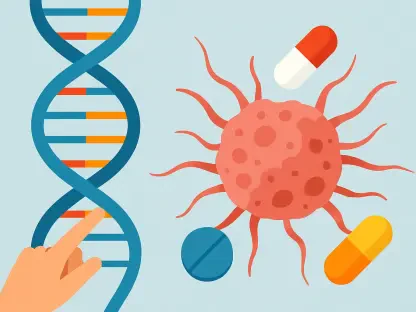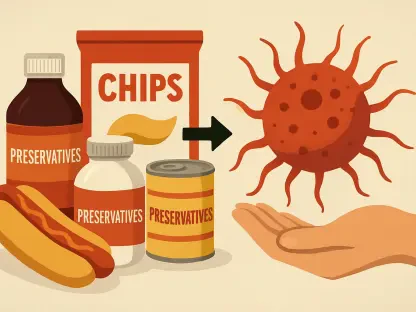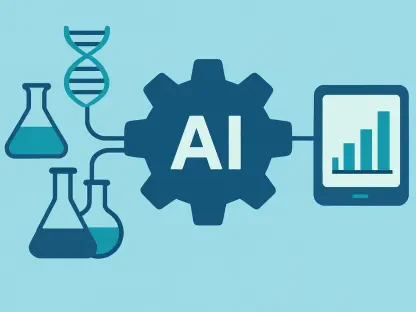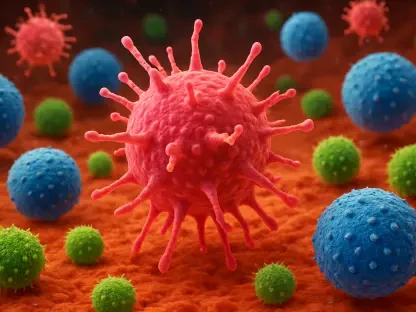The unforeseen impact of the COVID-19 pandemic initiated a global rush not only to discover vaccines but also to explore effective antiviral drugs capable of counteracting multiple coronaviruses. This effort has evolved beyond traditional scientific methods, incorporating surprising and innovative tools from fields such as artificial intelligence (AI) and film animation. These technological aids have been instrumental in fast-tracking the drug discovery process, revealing new approaches to combating viral threats. Central to this initiative is the Wyss Institute for Biologically Inspired Engineering at Harvard University, where interdisciplinary teams have successfully integrated cutting-edge technology with scientific expertise to address these urgent global health challenges.
Integration of AI in Drug Discovery
AI’s Role in Repurposing Existing Drugs
At the heart of this groundbreaking research is the strategic use of artificial intelligence to repurpose FDA-approved drugs as potential treatments for coronaviruses, including SARS-CoV-2. The interdisciplinary team, consisting of experts from various fields such as computational biology, infectious disease, and medicinal chemistry, aims to strategically leverage the capabilities of AI to optimize the drug discovery process. Traditional drug development timelines, which can span years, have been significantly compressed thanks to AI’s ability to process and analyze vast datasets with incredible speed and accuracy.
The Defense Advanced Research Projects Agency (DARPA) contributed initial support, emphasizing the importance of repurposing. The approach primarily involved screening a large array of existing drugs to determine their potential efficacy against the coronavirus’s Spike protein. AI modeling played a crucial role in enhancing the efficiency of this task, allowing researchers to simulate and predict drug interactions with the viral protein targets. This predictive modeling accelerates the identification of viable drug candidates, effectively transforming the traditional drug discovery methodology.
Targeting Stable Regions of the Spike Protein
A pivotal aspect of this AI-driven approach to drug discovery has been the focus on immutable regions of the Spike protein, crucial to the virus’s entry into host cells. Unlike previous strategies that targeted external, mutable sites that often succumb to evolutionary pressure and mutational changes, researchers shifted their focus to internal stable regions. These regions are less likely to mutate, presenting more reliable targets for therapeutic intervention. Through computational modeling and AI-assisted insights, researchers have gained a deeper understanding of these concealed regions, presenting a pivotal shift in how antiviral drug targets are identified.
This innovative approach offers a potentially more effective and enduring solution to inhibiting viral entry into cells. By anticipating the virus’s movements within these stable regions, the team could potentially block the infection process before it begins, effectively neutralizing the virus’s ability to propagate. This strategy not only combines advanced AI techniques with in-depth virological knowledge but also underscores a commitment to preemptive rather than reactive drug development, marking a significant shift in the scientific community’s approach to viral mitigation.
Film Animation in Molecular Visualization
Bridging Tech and Science with Animation
While AI has proven indispensable in computational prediction and analysis, the unexpected yet profound effect of film animation tools has marked a notable turning point in this research initiative. Traditionally rooted in creating visual effects for entertainment, film animation software now finds itself employed within scientific domains, offering novel insights into molecular behavior. This interdisciplinary crossover enables researchers to visualize dynamic structural changes within viral proteins, thus enhancing the identification of viable targets for drug development.
Film animation’s unique capacity to generate structures in motion has significantly enriched the scientific understanding of viral mechanisms. By animating the Spike protein’s movements, researchers can observe otherwise hidden configurations that appear during the virus’s interaction with host cells. This dynamic visualization enables more precise drug targeting, allowing scientists to proactively develop interventions that block viral entry paths. It exemplifies the transformative potential of technology when applied beyond its original scope, forging new pathways for scientific inquiry and technological advancement.
Generating Synthetic Data for AI Models
Equally transformative is the generation of “synthetic data” made possible through film animation tools. These tools offer an unparalleled ability to create realistic molecular simulations that feed into AI models, sharpening their predictive precision. By continuously animating folding and unfolding Spike protein structures, new layers of data are synthesized, allowing AI algorithms to learn from these models with increased accuracy. This dynamic synthetic dataset enables AI to refine its drug bind predictions and interactions, creating a synergistic effect between animation technology and computational analysis.
This infusion of synthetic data supports a more robust AI framework and expands the scope and scale of possible analytical insights. Researchers can explore theoretical scenarios far more efficiently, uncovering hidden correlations that could inform future drug design. The merging of film animation and AI reflects an innovative stride in hybrid technological applications, presenting a tangible example of how disparate fields can converge to produce groundbreaking advancements in the fight against viral diseases.
Breakthroughs and Challenges in Antiviral Discoveries
Bemcentinib’s Antiviral Potential
Central to this scientific advancement was the identification of bemcentinib, an FDA-approved drug initially considered for its potential antiviral properties. Using a combination of AI techniques and molecular docking studies, researchers efficiently screened thousands of drug candidates to pinpoint those that bind effectively to the Spike protein’s S2 subunit, a promising target within the viral structure. Bemcentinib emerged as an exceptional candidate due to its high predicted binding affinity and capability to function effectively as an orally available treatment option.
The drug’s ability to halt the virus at the pre-fusion stage and obstruct its entry into cells is a pivotal discovery in the ongoing battle against coronavirus variants. This discovery, combining AI-driven insights and in-depth molecular understanding, exemplifies how existing pharmacological resources can be reimagined amidst contemporary health crises. Bemcentinib’s mechanism, however, differed from its documented role of inhibiting the AXL kinase protein, opening avenues for identifying new drug designs tailored to innovative target sites within the Spike protein.
Designing Bemcentinib Analogs
Given bemcentinib’s dual action potential, researchers ventured into designing analogs that could maintain its antiviral efficacy without hindering the function of the AXL kinase. Pursuing analogs involved modifying bemcentinib’s molecular structure to optimize binding within the Spike protein while minimizing unintended interactions within biological systems. This intricate task required a delicate balance between computational predictions and empirical experimentation, drawing heavily from AI modeling and pharmacological expertise.
The iterative design and testing processes led to significant breakthroughs, notably the development of compounds like WYS-633 and WYS-694, which exhibited potent inhibition of the virus. Particularly, WYS-694 was shown to be over twelve times more effective than its predecessor, reflecting the success of precise analog adjustments. These compounds also demonstrated effectiveness against other coronavirus strains, showcasing the potential for meticulously designed analogs to address current and future viral threats. These explorations highlight the importance of strategic molecule redesign and underscore the role of interdisciplinary collaboration in refining antiviral therapeutics.
Future Implications and Technological Convergence
Broadening the Scope of Viral Mitigation
The successful integration of AI and film animation into the drug discovery process has broader repercussions for combating a myriad of viral diseases beyond coronaviruses, including influenza, HIV, and Ebola. As viruses continue to adapt and challenge existing medical interventions, the methodologies employed by researchers at the Wyss Institute offer a robust framework for rapid drug development. By embracing technological tools that update with speed and scale, the scientific community is equipped with adaptive capacities paramount for addressing modern viral threats.
Emerging viral strains underscore a critical need for adaptable and accessible therapeutic options. This advanced approach paves the way for strategizing combat measures against viruses, centering on robust scientific methodology and technological instruments. It highlights how proactive approaches transcending conventional practices can formulate effective responses to viral threats, ensuring a vigilant stance against upcoming infectious outbreaks.
Preparing for the Next Pandemic
The COVID-19 pandemic’s unexpected effects sparked an international push to not only develop vaccines but also find effective antiviral drugs that combat various coronaviruses. This mission has expanded past conventional scientific methods, embracing unexpected and pioneering tools from disciplines like artificial intelligence (AI) and film animation. These technological advancements have been pivotal in expediting the drug discovery process, uncovering novel strategies for tackling viral dangers. At the heart of this movement is the Wyss Institute for Biologically Inspired Engineering at Harvard University. Here, teams from different fields have successfully merged cutting-edge technology with scientific knowledge to confront pressing global health problems effectively. The pandemic has highlighted the necessity for rapid action and innovation, driving researchers to leverage new techniques and collaborations. By integrating AI and animation methods, scientists are finding creative avenues to accelerate drug development, aiming to stay ahead of emerging threats and safeguard global health. This interdisciplinary approach underscores the importance of innovative thinking in addressing complex health challenges today.









